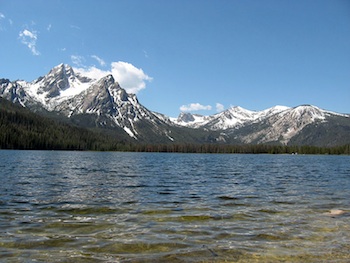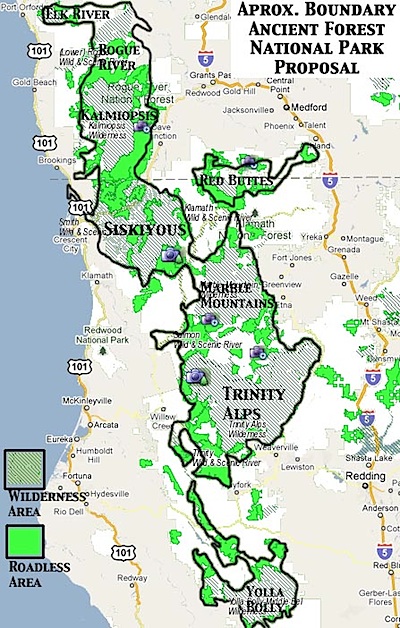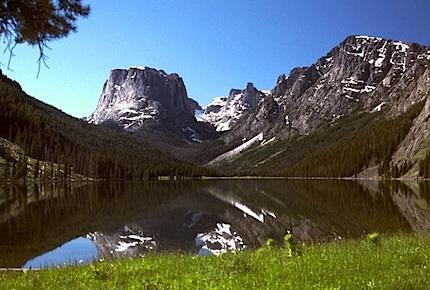Creating national parks doesn't happen every day. Lately, it seems the quickest way to create one is to legislatively redesignate a national monument as a national park (See Pinnacles National Park). But it doesn't hurt to dream, does it?
Here are five picks from the Traveler for new national parks. We offer up these nominees without consideration to fiscal impact because once you start to consider the costs -- mainly economic costs, but also political -- the possible can become impossible. With that understood, we view the following locations as truly spectacular places that should be preserved for future generations.
* Wind River Range, Wyoming
The Wind River Range in west-central Wyoming visibly defines spectacular. With 40 peaks that soar above 13,000 feet, including the state's highest point at 13,809 feet, glaciers, grizzlies, elk, bighorn sheep, lakes and trout streams, this craggy range runs roughly 100 miles north to south and 30 miles east to west.
Currently managed by the U.S. Forest Service, the range contains officially designated wilderness and is one of the country's premier hiking and backpacking areas. The range also harbors the headwaters of the Green River.
You can lose yourself in the Winds for days on end, spot North America's largest herd of bighorn sheep, find challenging climbing routes, or fancy yourself as a latter-day mountain man.
* Sawtooth National Recreation Area, Idaho
This 756,000-acre NRA long has been considered for inclusion in the National Park System. Indeed, back in 1911 a group of women in Idaho called for such a move, according to a history of the NRA's creation.

Stanley Lake in the Sawtooth NRA. Photo by Fredlyfish4 via Wikipedia.
In 1960, then-U.S. Sen. Frank Church introduced legislation to have the area considered for park status, and six years later even introduced a bill calling for Sawtooth National Park, but local opposition derailed it.
This wide expanse of wild lures river runners, climbers, backcountry skiers, anglers, backpackers and more. Cyclists challenge themselves on attacking the highway over Galena Summit, while families carry on long traditions of camping at Redfish Lake.
New England needs another national park, and the one proposed for the North Woods would not just be gorgeous, but would benefit wildlife species such as Canada lynx, Atlantic salmon and the eastern timber wolf threatened with extinction for lack of habitat and protect the "wild forests of New England."
The hardwood forests, lakes, and rivers would help build a strong recreation sector that would pump money into the surrounding towns. The streams and lakes here long have been plied by canoeists.
Talk of creating such a national park extends back over two decades. Proponents, along with pointing to the natural resources that could be protected, believe the cachet of a "Maine North Woods National Park" would bolster the region's economy through businesses that cater to park visitors.
* Ancient Forest National Park, California and Oregon
With climate change under way, protecting migrational routes, and providing migrational routes, for wildlife and even plants is vital to help ensure their survival.

The boundaries of the proposed Ancient Forest National Park run from Oregon south into California.
Park Service Director Jon Jarvis back in August of 2011 called for establishing "a national system of parks and protected sites (rivers, heritage areas, trails, and landmarks) that fully represents our natural resources and the nation's cultural experience." He also cited the need for creation of "continuous corridors" to support ecosystems.
The proposed 3.8-million-acre Ancient Forest National Park spanning parts of southern Oregon and northern California would meet those goals.
Within its proposed borders there already exist officially designated wilderness and roadless areas, places perfect for both recreation and wildlife.
The proposal is to set aside a solid block of land 3.8 million acres from the Rogue River in Oregon to the Eel River in California. It will forever allow the free migration of species from the coast and Redwood National Park to semi arid inland canyons. The park would include already established wilderness areas and already designated critical wildlife areas along with about 1 million acres of unprotected inventoried roadless areas.
* San Rafael Swell, Utah
Talk of turning the Swell into a national park has simmered for decades, going back to the 1930s when local officials proposed a "Wayne Wonderland National Monument." The proposal went nowhere, for the Swell, but is pointed to as an impetus for Capitol Reef National Park.
Nevertheless, the wondrous landscape of colorful reefs of rock, deep canyons, and sandstone walls bearing ancient pictographs remain. So, too, do the tales of outlaws such as Butch and Sundance losing possees by galloping into the maze of canyons. Within the Swell you can find ancient granaries, stone arches, bald eagles, bighorn sheep, feral horses and mules, homesteader cabins, and old mining operations. There are opportunities for canyoneering, river running, backpacking and day hiking and more.
Today there are fewer and fewer pristine and preserved areas left in the country, a fact that has the clock ticking on the few remaining places that deserve national park status. While much opposition no doubt exists to each of the above proposals, they could be crafted in such a way to mollify many of the critics.
By creating a "national park and preserve," the enacting legislation could be written in a way to allow some traditional ways of life, whether they involve grazing livestock, hunting, or logging in a sustainable fashion. Communities could remain in place, with the "park-and-preserve" boundaries excluding them.
What other places do you think should be added to the park system?




Comments
To a degree your right. But a lot of those national parks that were created before the 1900s were built by railroad companies. I recently spent some time in Great Sand Dunes, and that place is stunning. You don't have a single ice cream stand, and it was recently designated. You can walk far out into the dunes, or go up into the mountains, and truly not see anyone. Same can be said for other parks. Yosemite is something like 90% wilderness. You can definitely escape the crowds there if you leave the spots that most tourists go - Yosemite Valley, Wallwona, Toulame Meadows, and Glacier Point. Granted, if you go on a hike in some of these areas, you can start to escape those road hugging tourist types very quickly. the backcountry that is designated wilderness has a bounty of solitude.
SmokyMountainMan,Your 3 posts make more sense than the great majority of all the posts on this topic.Thank You for a voice of reason and common sense which I find pretty hard to find these days.
I disagree with your comments on the Great Smoky Mountains, Yellowstone, and Yosemite. I've been in the backcountry of all three parks. And currently live near the boundary of the Great Smokies. Other than the front country road areas, there are many stretches of this place you can go into and not see another soul, or you may encounter a few people, but it's only a brief occurance. I recently did a 30 mile loop, and it was a solo trip.
The Great Smokies are only a parking lot, if you are one of those National Park tourists that I refer to as a road hugger. As for Yellowstone, spend a few days out in the Bechler, or the Gallitans and come back and tell me they are overcrowded parking lots.
Kurt,I'm well aware of these other Geysers and sites in these parks.But you do have to get on those roads to get to them.I think it's unfair when the next guy always has to come back with wise remarks but I understand that is the nature of these blogs.
My orginal point was why cheapen the great parks by adding more and more just for the sake of calling it a national park.A national monument,seashore,historic site doesn't take anything away from them by not being called a National Park unless it has to do with money and that's what this is all about.
I don't think it's your place to take sides.I love the Natl Parks just like you.The biggest problem we have today are strong special interest groups running the show and that's not just our Natl Parks.
Go to hell and back again,God help all you.I gave you a thumbs up and you throw mud in my face.
I have just taken this dum website off my computer it all fighting and senseless babble by fools like you that think you have all the anwsers. That's why our country is ready to tank.
BYE
They need to dump Cuyahoga. The budgets for a park like that take away from other parks, and that's especially been the case during the sequestor. Personally, I think it's more important to make sure that the main parks that attract tourists from around the world get well funded so they can buying any existing private lands in their confines while also having the resources to keep the flora, fauna, and landscape protected. I read somewhere that the pseduo urban park at Golden Gate is a big drain on the NPS budget. Does this place deserve NPS status? I don't know. Maybe it should be sent to San Francisco and allow them to fund it, and those funds are instad diverted to protecting resources elsewhere. I really dont think urban parks like Cuyahoga and Golden Gate should eat into the budgets of Yosemite, etc.
Also, its great that many of the parks contain 80% of the landscape as wilderness. This is why I love National Parks, and keeps me going to them. Wilderness keeps development in the parks at bay, and while the roads maybe crowded, it doesn't take much to escape them. I have my fingres crossed that Yellowstone, Glacier, and Crater Lake finally get wilderness desingation within my lifetime. I don't want to see anymore development in those parks. I also would like to see Yellowstone expand it's boundaries. The Beartooths, and entire Gallitans should be a part of the park, and protected on the same level. To me that is more important than adding 50 more cuyahoga valleys. Protect what we have, and expand many of the current parks. Protecting more land around Acadia, the Smokies, Zion, Saguaro, the Redwoods is what i'd like to see.
As for current National Monuments in the system that deserve an upgrade, I think Organ Pipe Cactus and Dinosaur would be two that are next in line for the National Park upgrade. Mount Hood and Mt St Helens also have potential.
I think you're jumping the gun. When I saw your post calling the Great Smoky Mountains and Yellowstone (two places i've lived around), a parking lot, I feel i'd chime in with my own two cents on it, hence the purpose of a blog. I can easily avoid crowds in the Smokies, because I know that if you get beyond a mile of the road, and stay away from 5 main trails, and a few others during the weekends, that it's easy to escape. Yellowstone was the same way. Just stay away from a few main areas where the road huggies hang, and it's easy to have that "lost in the primitive of Yellowstone" experience. To state that they are just urban zoos is vastly unfounded. The Smokies still contain wild remote drainages that are realtively impenetratable during summer. An adventure that is definitely not of an urban zoo.
Hi Quiet please,
I work for RESTORE: The North Woods, the group that has been working to create a 3.2-million-acre Maine Woods National Park & Preserve. http://www.mainewoods.org
BTW, for others concerned about hunting, dogs, mountain biking, etc., the National Preserve portion would allow those uses.
I am not advocating turning everything into national parks, but the National Park System is far from complete. A good start would be adding 100 new parks by the 2016 National Park Service centennial.
I agree with you that money talks on this issue and everything else.
Best, Michael